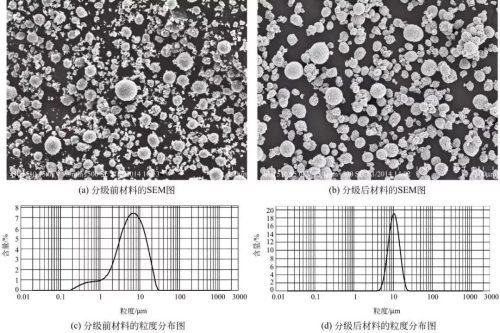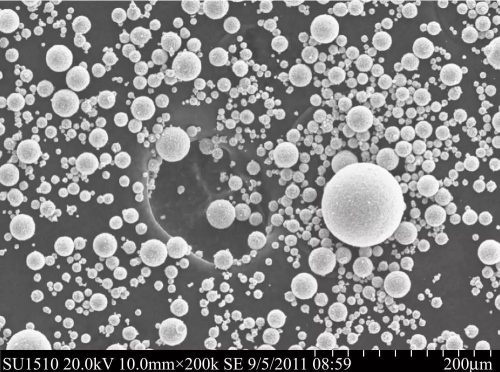The three main links in the production of ternary materials are mixing abrasives, high temperature sintering, crushing and decomposition. The control of each link and the performance of the equipment will have a direct or indirect impact on the final product. Among them, grading, screening and packaging are the last links of ternary materials. Let’s understand these links.
Grading
The particle size distribution of the ternary material will affect the specific surface area, compaction density, processing performance of the pole piece and the electrical performance of the battery. The crushing equipment can only control the particle size of the material, but cannot control the particle size distribution of the material. For the classification of ternary materials, an air classification device is generally added after the air pulverizer, and the pulverized products are directly classified.
According to the particle size distribution requirements of ternary materials, different air classifiers and classification processes can be selected.
It can be seen from the particle size distribution diagram that the particle size distribution of the product after classification is much narrower than that of the product before classification. It can be seen from the particle size distribution diagram that some small particles have been separated.
sieve
In order to avoid foreign matter or coarse particles in the material, it is also necessary to sieve the ternary material. The Dmax of the ternary material is at least less than 50µm, but sometimes the Dmax exceeds the standard. as the picture shows.
The Dmax of the material can be controlled by selecting the appropriate mesh screen. Ternary materials need to choose 300 mesh or 400 mesh screen.
Common screening machines include fixed grid screen, cylindrical screen, vibrating screen, etc. The commonly used screening machine for ternary materials is vibrating screen. The vibrating screen is the most widely used screen in the industry, which uses the vibration of the screen to screen. The number of screen vibrations is 900~3000 times·min-1. The range of the amplitude is 0.5~12mm, the smaller the amplitude, the more the number of vibrations. The inclination angle of the sieve is between 0 and 40 degrees.
The screening efficiency of vibrating screen is high, generally 80%~95%; the range of sieving raw material particle size is large, from more than 250mm to 0.1mm or 0.01mm; the output per unit area is large; it is easy to adjust, and the screen holes are less blocked. Such screens require special transmission equipment and consume power.
The ultrasonic controller and the vibrating screen are organically combined, that is, the ultrasonic vibrating screen. A high-frequency and low-amplitude ultrasonic vibration wave is superimposed on the screen, and the powder receives a huge ultrasonic acceleration, so that the material on the screen surface is always in a suspended state. Thereby, the blocking factors such as adhesion, friction, leveling and wedging are suppressed, and the performance is better than that of the vibrating screen.
Package
Ternary material packaging generally adopts vacuum packaging or vacuum and then fills with inert gas.
There are many varieties of vacuum packaging machines, which are usually divided into mechanical extrusion type, intubation type, chamber conveyor belt type, rotary table type and thermoforming type. The following is a brief introduction to the mechanical extrusion type vacuum packaging machine, the intubation type vacuum packaging machine and the chamber type vacuum packaging machine.
The principle of mechanical extrusion vacuum packaging is: after the packaging bag is filled, use elastic items such as sponges on both sides to remove the air in the bag, and then seal it. This method is the simplest, but the vacuum degree is low, and it is used in occasions where the vacuum degree is not required.
The biggest feature of the intubation vacuum packaging machine is that there is no vacuum chamber. During operation, the packaging bag is put on the straw, and the plastic bag is directly pumped or pumped-inflated. This model greatly simplifies the structure after eliminating the vacuum chamber, small size, light weight, low cost, low failure rate; high production efficiency, 2~3 times higher than the indoor vacuum packaging machine on average; the disadvantage is that the vacuum degree of the product is lower than the indoor vacuum Packing Machine.
Indoor vacuum packaging machines are available in the form of desktop, single-chamber and double-chamber types, with the same basic structure, consisting of a vacuum chamber, a vacuum/inflating system and a heat-sealing device. The vacuum/inflation system consists of a set of solenoid valves and vacuum pumps. The opening and closing of each valve is controlled by the controller to automatically complete the operation of vacuuming-inflating-heat sealing or vacuum-heat sealing.
The characteristics of the chamber type vacuum packaging machine are: compact structure, beautiful appearance, easy installation; high vacuum degree; manual bag placement and retrieval, so the productivity is not very high, among which the desktop and single chamber are lower, and the double chamber is slightly higher.
There are many varieties of vacuum packaging machines. When choosing a vacuum packaging machine, due to the different packaging sizes of each user, the requirements for different levels of vacuum packaging technology, and the requirements for work efficiency, it should be based on the characteristics of the user’s own products, the size of the packaging bag, etc. The basis for the user to determine the model is in addition to the sealing length of the packaging machine and the double row spacing. The maximum usable height of the vacuum chamber, etc., should also consider the following factors:
Packaging speed: In order to improve production efficiency, a double-chamber or multi-chamber vacuum packaging machine can be selected to improve the progress of the entire production.
Vacuum pump: It is the most important part of the vacuum packaging machine. The quality of the vacuum pump directly affects the packaging effect of the vacuum packaging machine.
Packaging machine material: Now there are painted cold plate cabinets and stainless steel cabinets. The best used in vacuum packaging machines is 304 stainless steel.
Vacuum degree: The packaging materials used in vacuum packaging are plastic composite films or plastic aluminum foil composite films, such as polyester/polyethylene, polyester/polypropylene, nylon/polyethylene, etc.



